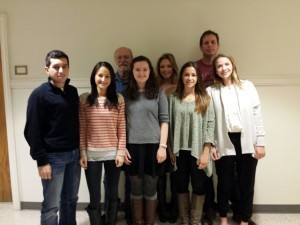Traveling Through Time and Space
Leonardo da Vinci was a man of an astounding number of talents and professions; among them –and most well-known— are painter and scientist. So it would seem fitting that the most recent project of Lafayette’s Technology Clinic would center on the Da Vinci Science Center in Allentown, a place that celebrates connections between science and art.

The students explore some of the current exhibits at the center.
In this yearlong project, a team of students from across the disciplines (humanities, sciences, social sciences, and engineering) was asked to find ways to make geology more appealing to the center’s young visitors. Led by geology professors David Sunderlin and Larry Malinconico and emeritus professor of anthropology Dan Bauer, these students –Sinan Dundar ‘15, Robyn Henderek ‘15, Kaitlin Kinsella ‘17, Madison Murray ‘16, Anna Wissler ‘16, and Sarah Woodruff ‘15-set forth to create an exhibit that was both engaging and interactive.
They excelled beyond expectations producing in concept a crawl-through tunnel, a virtual elevator, an interactive geological map, hands-on education stations, a geologic passport, and smartphone applications.
David Smith, the Edward and Inez Donley Senior Director of Science and Strategy at DSC, called it “the most creative earth science exhibit” he’d ever seen.
Hailing from different majors, students had to work collaboratively, often teaming up with each other to address one issue, then turning around and teaming up with another to troubleshoot an unforeseen obstacle. For example, when the idea of a crawl-through tunnel was presented, cost-effectiveness was a concern.
The result was a tunnel that allows visitors to crawl through with a GoPro camera, which is then fed to an exterior screen so others can simultaneously see and learn.
“We all have abilities we may not know we have, but we’re adaptable,” says Woodruff. “All the [group’s] viewpoints let us come up with the most creative solution to the problem.”
Another task was to make the language of geology more palatable to their visitors, namely, children. Henderek, who created the geologic maps using the ArcGIS program, was responsible for ensuring the information was scientifically accurate.

This year’s Tech Clinic designed creative geology exhibits for the Da Vinci Science Center .
“A lot of people write off geology as being boring – it’s just rock, deep time, and how old our earth is. We wanted to show that it’s very interesting and complicated,” she says. “I had never been part of a multidisciplinary group of people. It was cool for me to work with engineering, art, and biology students to put together a very interactive and multidisciplinary exhibit.”
Dundar, a mechanical engineer who worked on the virtual elevator and its accompanying video, agrees. “It was a good opportunity to work with people outside my field and see the creative side. The way I used to think about things is either I should do it perfectly or not at all. [Now I know] there’s so many things in between.”
Murray, who worked on the smartphone applications –from storyboarding to renderings, admits, “It was hard. None of us are the same discipline. Someone would put out an idea and we’d talk about it.”
The final result was “fantastic,” says Lin Erickson, the Executive Director and CEO of DSC.
“There are real things we can do. [These exhibit components] reinforce one another. We love doing projects with college students. You can see their backgrounds coming through in this – the sciences and the arts and the communications –they really played an important role in all the perspectives.”